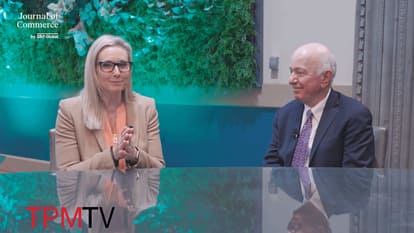- Program
- Speakers
- Who's Attending
- TPM Community
- Partners
- Media

TPM TV
Episodes of exclusive TPM content featuring interviews of key stakeholders and attendees.
WATCH NOW - About

About TPM
The must-attend conference for the trans-Pacific and global container shipping and logistics community
LEARN ABOUT TPM - FAQ's
- Get Updates
- Register
Blockbuster alliance announcements set the stage for 2025
September 18, 2024
Annual fall carrier network announcements are usually routine affairs. Carriers announce new rotations, and BCOs, forwarders, ports and terminals break out spreadsheets to work out the details of port calls, frequencies, transit times and estimates of reliability.
But the announcements last week were anything but routine; they could more appropriately be described as a thunderclap; a major moment in time for the industry writ large.
Not that the announcements by involving MSC, Maersk, Hapag-Lloyd, ONE, HMM and Yang Ming were a surprise; by and large they confirmed in broad brush terms what was already known or anticipated.
But they made strikingly real how as of next year the industry will be reconfigured both practically and philosophically after the breakup of the Maersk-MSC 2M alliance at the end of this year after a ten-year run going back to 2015. It is the largest shakeup of the alliance structure in a decade, coming at a time when overcapacity looms large due to a surge of ordering during the pandemic.
There will be a clear choice among the shipping public between direct services offered by most carriers and alliances and a hub and spoke network promising much higher schedule reliability offered by the new Maersk/Hapag-Lloyd Gemini alliance.
The alliance restructuring will see MSC, both the largest and fastest growing carrier in tonnage terms, operate as a stand-alone carrier, albeit with a series of new slot charter deals including with ONE in Asia-Europe and Zim in the trans-Pacific.
It will see Maersk team up with Hapag-Lloyd into the newly formed shuttle and hub port-based Gemini Cooperation. Its formation pulled Hapag out of THE Alliance, forcing the alliance of ONE, Yang Ming and HMM to regroup into the newly named Premier alliance.
But the big picture is hard not to miss. In its post-2M iteration MSC in effect takes the industry full circle, from carriers years ago operating independently on East-West trades, then forming into alliances, and now at least in the case of MSC being able, due to its immense scale, to emerge out of the alliance structure as the first post-alliance standalone carrier, wielding “full operational control” over 34 loops across five trade lanes.
In doing so, MSC breaks free of carriers’ sometimes unhappy marriages of convenience while exposing stark realities such as the fact that despite years of consolidation that relegated dozens of storied shipping brands to the history books – Sea-Land Service, Nedlloyd, P&O, United Arab Shipping, China Shipping, NYK Line, MOL, APL and many others – even most of the remaining carriers in the Alphaliner top 10 ranking are sub-scale in comparison to MSC, forced into alliances where their flexibility and decision making by definition is subject to consensus. That is why some industry leaders privately believe another round of consolidation could one day be coming.
The network announcements are a major moment also for how they reveal carriers’ divergent strategic directions. While MSC, the new Premier alliance and presumably the Ocean Alliance (which as of dxx had not announced its 2025 network), are operating traditional vessel loops with direct port calls on Asia-Europe, the premise – and promise -- of the Gemini alliance is that far greater end-to-end schedule reliability is achievable via shuttle services connecting to efficiently run hub ports.
That is a direct response to shippers’ growing dissatisfaction with atrociously low industry schedule reliability -- only 55% according to the most recent data from Sea-Intelligence – a product of blank sailings, port congestion in Asia and Red Sea diversions. For BCOs it means more inventory, earlier orders and inconsistent service to their own customers, thus more costly and less effective supply chains overall.
But despite the Gemini promise of 90%+ schedule reliability with the new network design, Maersk and Hapag-Lloyd will have to convince skeptical shippers who have long seen transshipments as time consuming and a visibility black hole. Their point is simple: shuttle services operating between two or three ports will not get delayed the way a 10-12 port call rotation will where a setback at one port sets the whole schedule back. But the Gemini network concept only works if the hubs remain consistently efficient, able to transship cargo so connections are made and containers keep moving fluidly on and off ships and through the yard.
About the Journal of Commerce
The Journal of Commerce is produced by a team of specialized, subject-matter expert journalists providing original daily news analysis of international logistics for corporate logistics teams and other participants in global supply chains. We are accountable to paying subscribers who demand that our news and analysis be accurate, fair, independent, and informative. Part of S&P Global, the editorial team leverages extensive data assets and relationships built over many years throughout trade and transportation to deliver trusted, executive-level insights relied upon by senior logistics executives. The Journal of Commerce group builds on its expertise and source relationships to develop industry-leading conferences including TPM, Breakbulk, and Inland Distribution.
